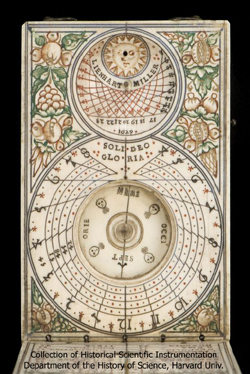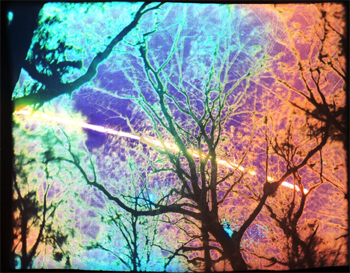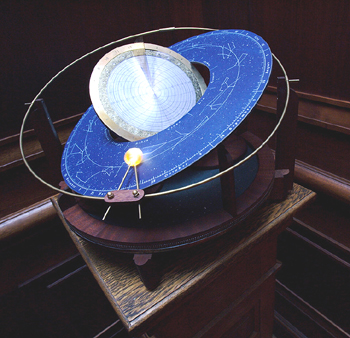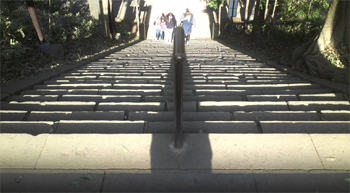 [CHSI - Harvard Collection]
|
Appropriate to NASS’ visit, Harvard had just recently completed a new major exhibit entitled “Time and Time Again” offering conference members a unique view on the changes in time keeping and the social impact of timekeeping technology. On Friday afternoon, NASS members followed the Time Trails through the Harvard campus, locating historical sundials “in the wild” and timepieces in the Semitic, Peabody, and Natural History Museums.
The day was finished by two presentations “Trading in Time: European Pocket Sundials Designed for Colonial Use in American Territories by Sara Schechner and “Portable Sundials in Austrian Museums” by Ilse Fabian.
During Saturday a plethora of sundial talks were presented by NASS members, including “Counting the Sunny Hours” by Roger Bailey to a new “Wandering Gnomon Sundial Designn” by Fred Sawyer. Bob Kellogg presented the making of an animation illustrating the Ibn al-Shatir sundial proposed for Observatory Park in Virginia for the Analemma Society. One of the most color presentations was Art Paque’s update on Solargraphy, illustrating the technique of forming daily images of the sun a photographic paper that at the last is digitally scanned and preserved.
 [Art Paque - Solargraphy - Oct 24th]
|
 [John Goodman - Annosphere]
|
 [Barry Duell - Senba Toshogu Shire Stair Alignment]
|
Larry McDavid continued the scientific instrument theme, presenting a detailed description of the Dent Dipleidoscope that offered unprecedented accuracy in measuring the sun’s noon transit. John Goodman then described the “Design of the Annosphere” a device with epicyclic grears to show the rotation of the earth throughout the year, predict sunrise and sunset and much more (http://www.annosphere.com).
Barry Duell continued his exploration of shadows at the Senba Toshogu Shrine, looking at stair shadows and the relation to near Easter alignments. At Senba Toshogu Shrine there are already two moveable feasts celebrated the anniversary of Ieyasu's triumphant entry into Edo, and Kuyo for Ieyasu's bones to be interned). The shrine built (1st-1633, 2nd-1640) at the time of Japanese Christian persecution, might harbor other hidden alignments for Easter, celebrating Jesus in parallel with Ieyasu's death.
Many other intriguing sundial talks were presented. Read more from the attachment.
